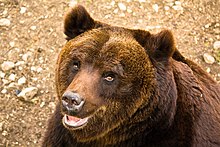Marsican brown bear
| Marsican brown bear | |
|---|---|
 |
|
| Scientific classification | |
| Kingdom: | Animalia |
| Phylum: | Chordata |
| Class: | Mammalia |
| Order: | Carnivora |
| Family: | Ursidae |
| Genus: | Ursus |
| Species: | U. arctos |
| Subspecies: | U. a. marsicanus |
| Trinomial name | |
|
Ursus arctos marsicanus Altobello, 1921 |
|
The Marsican brown bear (Ursus arctos marsicanus) (Italian: orso bruno marsicano), also known as the Apennine brown bear, is a critically endangered subspecies of the brown bear, with a range restricted to the Abruzzo National Park, and the surrounding region in Italy. The Marsican Brown Bear is very similar to a regular brown bear with slight differences in their appearance and hibernation techniques. Baby Marsican bears tend to grow up fairly quickly. They are restricted to the National Parks the Italian government reserved for them. With their existence dwindling, the Italian government has recently begun to stress their conservation. The park has become a sanctuary dedicated to animals such as the Marsican, with hopes of rekindling the large, yet isolative bears once thriving existence. In recent years, more conservation groups have tried to help this bear. Debate exists as to whether it should be considered a subspecies or a taxon of its own.
The Marsican Brown Bear lives their lives in isolation. With their existence dwindling, the 50 bears that remain in the Abruzzo National Park have characteristics that differ from their sibling subspecies. The Marsican Brown Bear, otherwise known as the Abruzzi Brown Bear, have a relatively calm temperament, with no aggression shown towards humans. In terms of size, the male Marsican Bear is larger than most of the brown bear subspecies, which a weight of around 480 pounds, while the female is significantly smaller, at around 310 pounds. These bears are known to be omnivorous in nature, mainly eating berries, while occasionally eating small animals such as chickens and other livestock. All of these traits the bear shows can likely be attributed to its existence in isolation.
In a standing position, the Marsican Brown Bear can reach heights of up to 2 meters. Their large size, as well as noticeably different forepaws to their rear are characteristics that help distinguish their presence. The footprints, hair residue, color of feces, and claw marks the bears leave are special to their species. These large mammals have been spotted rolling rocks over in search of insects as well as reaching high into branches looking for berries, honey, etc. Their great sense of smell makes up for their mediocre eyesight when it comes to searching for food.
...
Wikipedia

